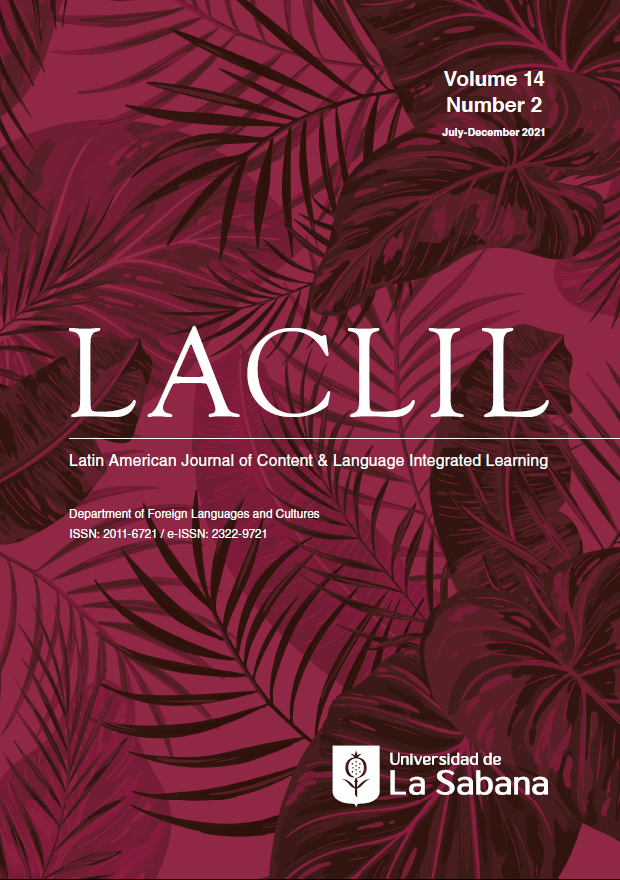Content and Language Integrated Learning (CLIL) in a Medicine Program in Colombia: Results of a Perception Survey in Students
DOI:
https://doi.org/10.5294/laclil.2022.14.2.2Keywords:
Higher education, teaching methods, bilingual programs, integrated education, medical educationAbstract
This study collected the perception of medical students about the use of English for teaching through the use of a strategy based in Content and Language Integrated Learning (CLIL) approach at Universidad Tecnológica de Pereira (UTP) Colombia. A descriptive observational quantitative research was conducted in a group of 128 students of medicine who agreed to participate in the strategy called “Strategy for Paper’s Bilingual Presentation (SPBP)” in the subjects of Surgical Clinic I and II. Of this group, 98.5% (126) considered learning English important in their training and 86% (110) essential to advance without difficulties in their studies. In addition, there was a 52.3% (67) of students who stated that the University should foster the use of English integrated with contents in specific programs. In reference to the teaching of English at the University, 85.9% (110) of the students considered that it should be integrated into the content of the academic programs. The didactic strategy was positively evaluated by 86.7% (111), and 61% (78) used English exclusively or preferentially. Scenic fear and lack of knowledge of technical language were arguments for the preferential use of Spanish in the session. Among the recommendations made by the students were the extension of the preparation time for the activity, the inclusion of clinical cases, and the selection of the assigned topics with the teacher. The didactic strategy used proved to be very useful and replicable in other semesters and training levels of the Medicine program. It is imperative to design and promote bilingual spaces that allow the use of English as a strategy to integrate contents and language in the teaching of Medicine.
Downloads
References
Abi-Raad, V., Raad, K., Daaboul, Y., Korjian, S., Asmar, N., Jammal, M., & Bahous, S. A. (2016). Medical education in a foreign language and history-taking in the native language in Lebanon–a nationwide survey. BMC Medical Education, 16(1), 298–303. https://doi.org/10.1186/s12909-016-0826-7
Alshareef, M., Mobaireek, O., Mohamud, M., Alrajhi, Z., Alhamdan, A., & Hamad, B. (2018). Decision makers’ perspectives on the language of instruction in medicine in Saudi Arabia: A qualitative study. Health Professions Education, 4(4), 308–316. https://doi.org/10.1016/j.hpe.2018.03.006
Arias, E. (2017). Translingüísmo y aprendizaje integrado de lengua y contenido como un modelo de educación bilingüe dinámica en dos colegios públicos de Pereira. Universidad Tecnológica de Pereira.
Banegas, D. L. (2015). Sharing views of CLIL lesson planning in language teacher education. Latin American Journal of Content & Language Integrated Learning, 8(2), 104–130. https://doi.org/10.5294/laclil.2015.8.2.3
Bonilla-Medina, X. (2012). TEFL educational principles: A proposal for changing times. Colombian Applied Linguistics Journal, 14(2), 181–192. https://doi.org/10.14483/udistrital.jour.calj.2012.2.a11
Burbano, P. A. A., Machado, L., & Pérez, V. (2016). Assessment of a bilingual program based on content and language integrated learning in a state school of Pereira [Tesis de grado, Universidad Tecnológica de Pereira]. Repositorio Institucional - Universidad tecnológica de Pereira.
Council of Europe. (2020). Common European Framework of Reference for Languages: Learning, Teaching, Assessment – Companion Volume. Council of Europe Publishing, Strasbourg, available at www.coe.int/lang-cefr.
Coyle, D., Hood, P., & Marsh, D. (2010). CLIL: Content and Language Integrated Learning (CLIL). Cambridge University Press. https://doi.org/10.1017/9781009024549
Dale, L., & Tanner, R. (2012). CLIL activities with CD-ROM: A resource for subject and language teachers. Cambridge University Press.
Echevarria, J., Short, D., & Powers, K. (2006). School reform and standards-based education: A model for English-language learners. The Journal of Educational Research, 99(4), 195–211. https://doi.org/10.3200/JOER.99.4.195-211
Fandiño-Parra, Y. J., Bermúdez-Jiménez, J. R., & Lugo-Vásquez, V. E. (2012). Retos del Programa Nacional de Bilingüismo. Colombia Bilingüe. Educación y Educadores, 15(3), 363–381. https://doi.org/10.5294/edu.2012.15.3.2
García, O. (2011). Bilingual education in the 21st century: A global perspective. John Wiley & Sons.
Gavrilova, E., & Trostina, K. (2014). Teaching English for professional purposes (EPP) vs content and language integrated learning (CLIL): The case of Plekhanov Russian University of Economics (PRUE). European Scientific Journal. ESJ, 10(10). https://doi.org/10.19044/esj.2014.v10n10p%25p
Hutchinson, T., Waters, A., & Swan, M. (1987). English for specific purposes. Cambridge University Press. https://doi.org/10.1017/CBO9780511733031
Lee, I. (2017). Classroom writing assessment and feedback in L2 school contexts. Springer. https://doi.org/10.1007/978-981-10-3924-9
McDougald, J. S., & Ayure, C. P. A. (2020). Expanding the value of CLIL: Perspectives from primary to higher education. Latin American Journal of Content & Language Integrated Learning, 13(2), 155–162. https://doi.org/10.5294/laclil.2020.13.2.1
Roca, B., Gironés, G., Roca, M., & Díaz, D. (2015). Actitud de los alumnos del Grado de Medicina de una universidad pública española ante la utilización del inglés como lengua vehicular de la enseñanza. Educación Médica, 16(4), 223–226. https://doi.org/10.1016/j.edumed.2015.10.007
Rubio-Alcala, F. D., Arco-Tirado, J. L., Fernandez-Martin, F. D., López-Lechuga, R., Barrios, E., & Pavon-Vazquez, V. (2019). A systematic review on evidences supporting quality indicators of bilingual, plurilingual and multilingual programs in higher education. Educational Research Review, 27, 191–204. https://doi.org/10.1016/j.edurev.2019.03.003
Ruiz-Garrido, M., & Fortanet-Gómez, I. (2009). Needs analysis in a CLIL context: A transfer from ESP. CLIL practice: Perspectives from the field, 179–188.
Rus, D. (2019). Assessment techniques in teaching English for specific purposes to engineering students. Procedia Manufacturing, 32, 368–373. https://doi.org/10.1016/j.promfg.2019.02.227
Stapel, A. (2016). Content and Language Integrated Learning (CLIL) in medicine programs in higher education. Giessener Elektronische Bibliothek.
Zirene, J. d. D. U. (2012). Importancia del idioma inglés en las instituciones de educación superior: el caso de la Corporación Universitaria de Sabaneta. Uni-pluriversidad, 12(2), 97–103.
Downloads
Published
How to Cite
Issue
Section
License
Copyright (c) 2022 Latin American Journal of Content & Language Integrated Learning

This work is licensed under a Creative Commons Attribution-NonCommercial-NoDerivatives 4.0 International License.
This Journal and its articles are published under the Creative Commons CC BY 4.0 DEED Attribution 4.0 International license. You are free to: Share — copy and redistribute the material in any medium or format for any purpose, even commercially. Adapt — remix, transform, and build upon the material for any purpose, even commercially. The license cannot revoke these freedoms as long as you follow the terms of the license.








